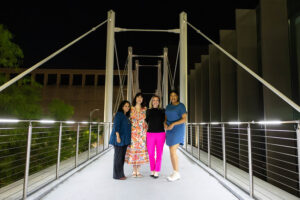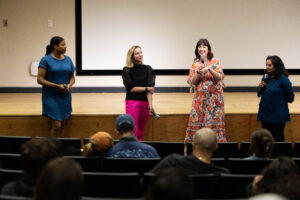Journalists from nonprofit news outlet The 19th* set the tone for the 25th International Symposium on Online Journalism during this year’s pre-ISOJ event on April 11, a screening of the new documentary “Breaking the News” about the newsroom’s launch and subsequent success.

Panelists for a Q&A after the screening of documentary “Breaking the News.” (Patricia Lim/Knight Center)
Following the screening, Sonal Shah, CEO of The Texas Tribune, moderated a panel featuring Emily Ramshaw, co-founder and CEO of The 19th*; Amanda Zamora, also a co-founder of The 19th*; and Princess A. Hairston, co-director of the documentary. Award-winning filmmakers Heather Courtney and Chelsea Hernandez also co-directed the film.
The film, which premiered earlier this year, follows Ramshaw, Zamora and their colleagues for three years to document the trajectory of The 19th* after its launch in 2020. After working for The Texas Tribune, Ramshaw and Zamora said they were inspired to create The 19th* because traditional “legacy media” lacked underrepresented voices from gender-diverse and racially-diverse individuals, so their stories often went untold.
“If you think about the crisis in local news and how many local news organizations are struggling, it’s also been a bit of a golden era for journalists who are not just going to wait around for legacy news to solve for information needs in their communities,” Zamora said. “I’m very interested to see what becomes of this sort of inflection point.”
In addition to highlighting leadership efforts within The 19th*, the documentary also followed three journalists from the news organization: economy reporter Chabeli Carrazana, LGBTQ+ reporter Kate Sosin and editor-at-large Errin Haines. The reporters are seen covering stories that characterized the years following The 19th*’s founding, including the COVID-19 pandemic, 2020 election, Jan. 6 insurrection and legislative attacks on reproductive and LGBTQ+ rights.
With about 50% of its audience identifying as BIPOC, Zamora said The 19th*’s coverage is unique because each story considers how racial and gender diversity intersect with policy.
“This idea of solving for equity really starts with how you operate and how you function … what the culture is like,” Zamora said. “It’s an iterative, never-ending process. It’s not a box that you can check.”
To open the Q&A portion of the event, Shah asked Ramshaw and Zamora why they decided to leave the Tribune to create their own news startup, especially in the midst of a global pandemic. Ramshaw said the idea came after the 2016 election results when she wondered how the media potentially influenced voting outcomes.
“I don’t think any of us ever thought we were going to start a newsroom in the pandemic,” Ramshaw said. “... For both of us, looking down the barrel of the 2020 election, there were more women than ever on the 2020 stage. There were more women of color. There were more queer people. And I think we were pretty determined that the media not make those same mistakes.”
Zamora said before the 19th*, she’d come to the conclusion that there was something “fundamentally broken” about political journalism. Newsrooms should reflect the diversity of the public they serve, she said.
“I started to really question what the media’s role is in addressing that problem, and looking around the room and the journalists doing this coverage, [I thought] what is their approach to the journalism?” Zamora said.
When asked about the filmmaking process, Hairston said the production crew had to be incredibly careful about how they conducted interviews and acquired footage due to COVID-19 limitations.
“We had to really strategically direct, produce and try to think about how we can film as much as we could to build scenes because it was an isolating experience,” Hairston said. “A lot of times, we were the only people in their spaces.”
Noted in the film and Q&A, The 19th* underwent significant transformations in its first few years as the staff pushed for a more inclusive, revolutionary newsroom. Ramshaw said The 19th* started specifically with women in mind as the intended audience, but reporters like Sosin pushed the The 19th* to adopt more gender-inclusive language and story angles.
Additionally, Zamora said the newsroom quickly grew into a space that prioritizes mental health, encouraging reporters to speak up when their work becomes an emotional struggle.
“That’s another conversation that’s happening in our industry that’s long overdue,” Zamora said. “What are the sort of direct or indirect exposures to trauma for frontline reporters … and how are we going to address that as an industry?”
When asked by a journalism student about objectivity, Ramshaw said those who preach objectivity in the industry are perpetuating “journalism told through the white male gaze.” She said true journalistic objectivity has always been a myth because people naturally make choices with their values in mind.
“We’re going to cover everybody without fear or favor, but we’re not going to play the both sides game if one side is spewing disinformation and factual accuracies.”

Sonal Shah, Emily Ramshaw, Amanda Zamora and Princess Hairston during the Pre-ISOJ documentary screening, “Breaking the News” at Moody College of Communication on April 11, 2024. (Patricia Lim/Knight Center)
To wrap up the event, Zamora and Ramshaw discussed how The 19th* journalists approach coverage and decide which stories to tell.
“For us, the choices are made in two ways,” Ramshaw said. “The first is the ways in which our audiences are negatively disproportionately affected. The other way is where we see hope and outliers — the women of color who are leading extraordinary movements and who are normalizing women’s leadership.”
Sarah Brager is a third-year journalism student at UT Austin with an interest in political, environmental and data reporting. She currently works as a news desk editor for The Daily Texan and a journalism coach for the Moody Writing Support Program. This is her second year covering ISOJ.